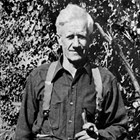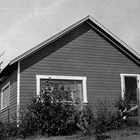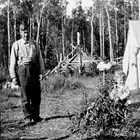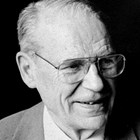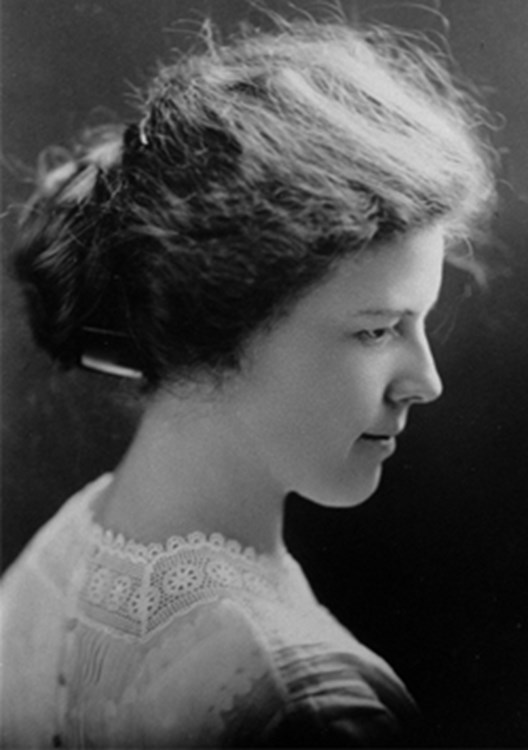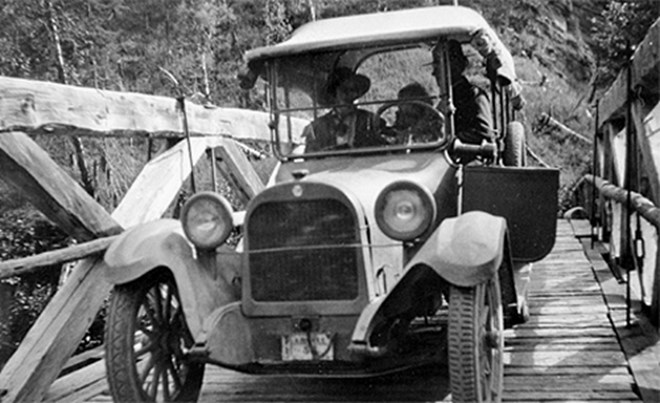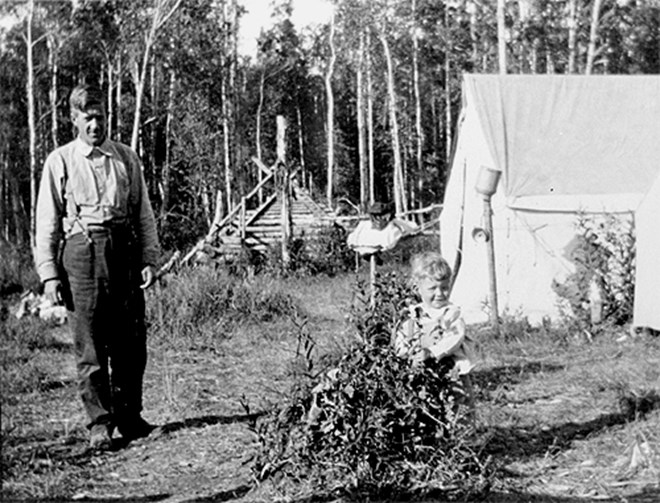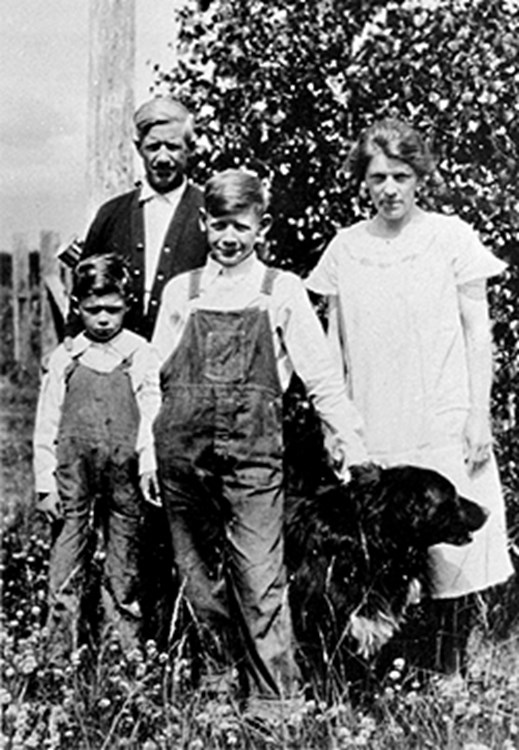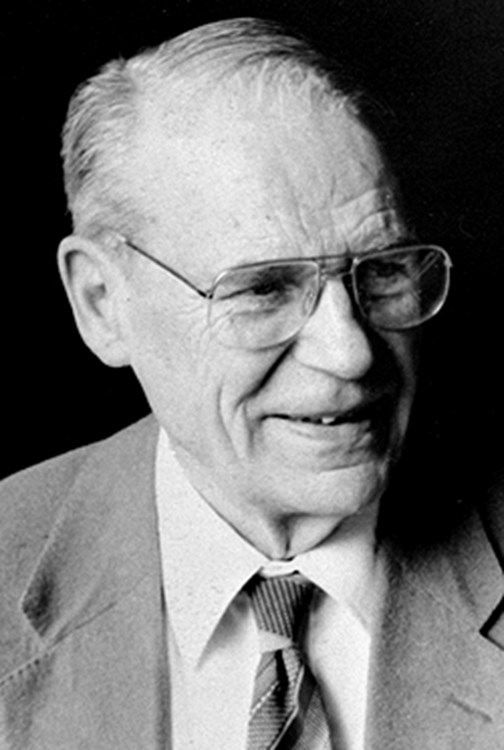Tryck, Oscar
1879-1964 | Superintendent, Alaska Road Commission, at Wasilla
Oscar [Oskar] Tryck was born in Järnboås, Örebro, Sweden, on October 21, 1879, the son of Erik Wilhelm Tryck and Klara Gustafva Larsson.[1] He immigrated to the United States with his parents in 1880.[2] He was raised in the depressed iron ore area of Michigan, the area around National Mine, Michigan.
In 1902 or 1903[3], Tryck, with his brother, Charles, and three other men, set out for Alaska to join the Klondike gold rush. They crossed the country and then traveled by steamship from Seattle to Skagway. They hiked the White Pass along the rail line, built a scow on Lake Bennett, and floated down the Yukon River to Dawson, where they worked in the gold mines. They continued their trip, crossing into Alaska. Tryck also worked in Rampart, Tanana, Tenderfoot, and Fairbanks, as a wood cutter, freighter, road builder, and at other jobs to earn a living. In Tanana, he worked supplying wood for Fort Gibbon, the U.S. Army post at the mouth of the Tanana River. He prospected and hauled freight for the Tenderfoot Mine on Tenderfoot Creek, in the Richardson District near Fairbanks. In 1911, he began hauling freight with a matched team of four black draft horses out of Fairbanks and on the Richardson Trail to Valdez.[4]
In 1911, Tryck heard of the gold strike at Ruby and left Fairbanks on the Julia B, the first sternwheeler down the river to the new gold strike. The gold discovery at Long Creek, thirty miles south of Ruby and near the mouth of the Yukon River, led to a small stampede. In 1911, the town of Ruby, the only sizeable gold camp ever developed on the lower Yukon River, was established, and it peaked with a population of one thousand. In Ruby, Tryck took over the job of pioneering the road out to the mines, with his horses and a crew of pick-and-shovel men. He also mined with his brother, and they hit a pay streak on Trail Creek. In comparison with Fairbanks and Nome, the gold placers in Ruby were not comparable in yield. By 1918 Ruby was fading fast and soon went the way of other short-lived mining towns.[5]
In 1913, Tryck returned to Iron Mountain, Michigan, and married Lillian "Blanche" Tipping, a school teacher and his childhood sweetheart. She was born in National Mine, Michigan, the daughter of Irish immigrant parents, William Tipping and Katherine Catherina Hodge Smith. She had been waiting for Oscar for ten years, and the two were married in Ishpeming, Michigan, on February 2, 1914.[6] They returned to Fairbanks via Valdez, and waited for the spring break up on the river to travel to Ruby. In 1915, their first child, William Oscar, was born in Ruby. By 1916, the Trail Creek claims were worked out, and he moved the family to Anchorage via Knik. Tryck hauled freight to the mines until construction of the Alaska Railroad eliminated the need for Knik as a supply port.
In 1917, the Tryck family moved to Wasilla, a new town where the railroad crossed the Knik Road. He bought some lots in the Wasilla (railroad) townsite auction. On December 9, 1919, a second son, Charles Warren, was born in Wasilla, reportedly the first baby born there.
In 1917, Tryck began working for the Alaska Road Commission (ARC) as a general foreman for the Matanuska Valley and the Willow Creek mining district. He later became the superintendent of the ARC at Wasilla under the Anchorage district until his retirement in 1937. During his tenure with the ARC, he supervised the construction of many of the connecting roads in the Wasilla-Palmer-Anchorage area built prior to 1936. In the Matanuska Valley, the ARC built Trunk Road, Fishhook Road, and Finger Lake Road, now the Palmer-Wasilla Highway. They also built the road from Willow to the Lucky Shot Mine and Independence Mine, completing the loop that goes through Hatcher Pass, and to other now abandoned mines. The ARC also built most of the first road connecting Anchorage with the Matanuska Valley, the Anchorage-Matanuska highway.[7]
Lillian "Blanche" Tryck was active in community affairs and served as clerk of the Wasilla School Board. She and Oscar were instrumental in the establishment of a territorial elementary school, a one-room school with one teacher for eight grades.[8]
Lillian “Blanche” Tipping Tryck died on July 8, 1936, in Wasilla, from a cerebral hemorrhage.[9] Oscar Tryck died on April 20, 1964, in Providence Hospital in Anchorage after a short illness. They are buried in the Anchorage Memorial Park Cemetery.[10] They were survived by two sons, William and Charles; and eight grandchildren. Charles Tryck was a partner in the Anchorage-based engineering firm, Tryck, Nyman Hayes, Inc. (TNH).[11]
Endnotes
[1] Oskar Tryck, Swedish Church Records Archive, Johanneshov, Sweden, Indexed Birth Records, 1880-1920, GID Number 100018.52.19800, Roll/Fiche Number SC-1023, Volume 670, 1879, in Sweden, Indexed Birth Records, 1860-1941 [database on-line], http://ancestry.com (accessed November 5, 2016); and Oscar Tryck, Michigan, Marriage Records, 1867-1952 (Lansing, MI: Division for Vital Records and Health Statistics, Department of Community Health), in Michigan, Marriage Records, 1867-1952 [database on-line], http://ancestry.com (accessed November 5, 2016).
[2] Oscar Tryck, 1910 U.S. Census, Tenderfoot, Tanana Recorder’s District, Fourth District, Alaska, ED 11, page 3B, National Archives Microfilm Publication T624, Thirteenth Census of the United States, 1910, Roll 1749, 1910 Federal United States Census [database on-line], http://ancestry.com (accessed November 5, 2016).
[3] Two newspaper articles, “Gold Rush Pioneer Oscar Tryck Dies,” Anchorage Daily Times, April 21, 1964, 2, and “Tryck Rites are Slated,” Anchorage Daily Times, April 24, 1964, 11, stated that Oscar Tryck first arrived in Alaska in 1902 to join the Klondike gold rush. Tryck’s son, Charles Warren Tryck, wrote in Fond Memories of Anchorage Pioneers, Vol. II, that his father’s Alaska trip occurred in 1903.
[4] Fond Memories of Anchorage Pioneers, Vol. II (Anchorage: Pioneers of Alaska, Igloo 15, Auxiliary 4, 1996), 162; and “Gold Rush Pioneer Oscar Tryck Dies,” Anchorage Daily Times, April 21, 1964. 2.
[5] See, Golden Places: The History of Alaska-Yukon Mining, Chapter 7: Other Stampedes, Ruby, National Park Service, https://www.nps.gov/parkhistory/online_books/yuch/golden_places/chap7.htm (accessed November 5, 2016); and John P. Bagoy, Legends & Legacies, Anchorage, 1910-1935 (Anchorage: Publications Consultants, 2001), 145-146.
[6] Oscar Tryck and Lillian B. Tipping, Return of Marriages in the County of Marquette, Michigan, January 27, 1914 [date of marriage: February 2, 1914], Michigan, Marriage Records, 1867-1952 (Lansing, MI: Division for Vital Records and Health Statistics, Michigan Department of Community Health), Michigan, Marriage Records, 1867-1952 [database on-line], http://ancestry.com (accessed November 5, 2016).
[7] Fond Memories of Anchorage Pioneers, Vol. II, 162; “Gold Rush Pioneer Oscar Tryck Dies,” Anchorage Daily Times, April 21, 1964, 2; “Mrs. Oscar Tryck Dies in Wasilla; Rites Here Sunday,” Anchorage Daily Times, July 10, 1936, 4; Sharon Bushnell, "Alaskana Interview - Wasilla's Firstborn: Charles W. Tryck," Anchorage Daily News, December 5, 2004, D-3; and oral history interview, with Charles and Mollie Chamberlain Tryck, interviewed by Stephen Haycox and Maureen Cowles, transcribed by Gail Hoshiko-Reed, January 22, 1992, 11 and 14, File 22, Anchorage Pioneers Oral History Project, Oral History Transcripts, 1992-1995 (HMC-0466), Box 1, Archives and Special Collections, Consortium Library, University of Alaska Anchorage, Anchorage, AK.
[8] Fond Memories of Anchorage Pioneers, Vol. II, 162.
[9] “Mrs. Oscar Tryck Dies in Wasilla; Rites Here Sunday,” Anchorage Daily Times, July 10, 1936, 4.
[10] Oscar Tryck, U.S., Find a Grave Index, 1600s-Current [database on-line], http://ancestry.com (accessed November 5, 2016); and Blanche Tryck, U.S., Find a Grave Index, 1600s-Current [database on-line], http://ancestry.com (accessed November 5, 2016).
[11] See, John Strohmeyer, Historic Anchorage: An Illustrated History (San Antonio, TX: Historical Publishing Network for the Anchorage Museum Association, 2001), 137.
Sources
This biographical sketch of Oscar Tryck is based on an essay originally published in John P. Bagoy's Legends & Legacies, Anchorage, 1910-1935 (Anchorage, AK: Publications Consultants, 2001), 145-146. See also the Oscar Tryck file in the Bagoy Family Pioneer Files (2004.11), Box 8, Atwood Resource Center, Anchorage Museum at Rasmuson Center, Anchorage, AK. Photographs courtesy of the Tryck family. Edited by Mina Jacobs, 2012. Note: edited, revised, and expanded by Bruce Parham, November 6, 2016.
Preferred citation: Bruce Parham, ed., “Tryck, Oscar,” Cook Inlet Historical Society, Legends & Legacies, Anchorage, 1910-1940, http://www.alaskahistory.org.
Major support for Legends & Legacies, Anchorage, 1910-1940, provided by: Anchorage Museum at Rasmuson Center, Atwood Foundation, Cook Inlet Historical Society, and the Rasmuson Foundation. This educational resource is provided by the Cook Inlet Historical Society, a 501 (c) (3) tax-exempt association. Contact us at the Cook Inlet Historical Society, by mail at Cook Inlet Historical Society, Anchorage Museum at Rasmuson Center, 625 C Street, Anchorage, AK 99501 or through the Cook Inlet Historical Society website, www.cookinlethistory.org.

